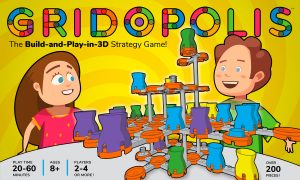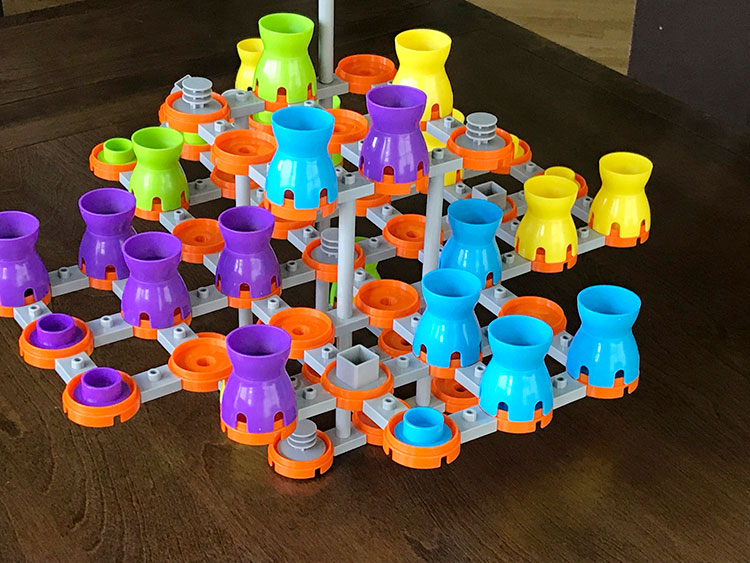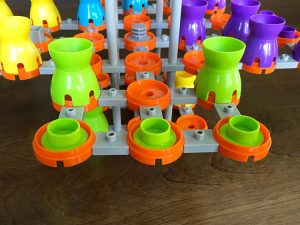 I’ve always enjoyed abstract strategy games and one that has always intrigued me was from the original 1966 Star Trek series; 3-Dimensional Chess. I must admit I’ve never played it but the concept of taking a classic game like chess playing it on a 3D board was cool and rather genius by design.
I’ve always enjoyed abstract strategy games and one that has always intrigued me was from the original 1966 Star Trek series; 3-Dimensional Chess. I must admit I’ve never played it but the concept of taking a classic game like chess playing it on a 3D board was cool and rather genius by design.
This brings us to Gridopolis from Gridopolis Games. This 3D abstract strategy game can be played with 2-4 players in about 30-60 minutes.
Gameplay Overview:
Depending on the player count will determine which starting Grid-Set (i.e. 3D player board) players will use. There are great starting sets in the rule book, with more advanced and different Grid-Sets designs on www.gridopolis.games/ideas.

For the basic rules of Gridopolis, think checkers, not chess. Players start with 6 Pawns of a unique color and these markers can only move one space (either forward, diagonal, sideways, or another level) – just never backwards. Pawns can jump opponents Pawns and capture them.
Each starting Grid-Set is made up of pads, posts, Kingerizer, and Hyper-Pad. The pads and posts make up the 3D Grid-Set. The Kingerizer is color coded for each team. This is where that color of Pawn will start (i.e. their Home-Row). If an opponent lands on an opponent’s Kingerizer, it’s turned into a King and now can move 2 pads and in any direction. The Hyper-Pads let Pawns or Kings beam to another Hyper-Pads in the Grid-Set and doesn’t count as a move.
Players will also receive 2 posts, 2 pads, and 2 blocker boxes to add to the starting Grid-Set in lieu of Pawn or King movement. The posts and pads can possibly create another level of the Grid-Set and grow it. The blocker box – like its namesake, blocks movement and no Pawn or King may land on it.
A player wins the game when only their Pawn or King marker(s) remain on the Grid-Set.

Game Experience:
I will admit I didn’t know what to think when I first received Gridopolis. I never heard of this game or publisher and I just hoped my son would like it. From the start, Gridopolis won my son, his friends, and me over quickly. The rules are easy to pick up and after you build the Grid-Set, the game is engaging for those playing it. The hard thing to learn is the 3D movement and especially capturing an opponent’s piece. But after a few playthroughs and some practice, all of us fully grasped it.

I polled the kids to what they liked and didn’t like about Gridopolis. They all loved that the Grid-Sets are modular and no matter the starting design, by the end of the game it was always different. They all had a blast adding pieces throughout their plays, especially when they were stumped for a move and could place a piece for possibly their next move or try to foil an opponent.
And of course, they all loved the 3D movement of their pawns and kings. It was funny that as soon they got the hang of it, they were moving around so fast that it was hard to track sometimes. They had fun with the 3D movement from start to finish.
The last positive I wanted to note was that I chatted with the designer Dave Schultze and Marketing VP, Max Rosenblum. Gridopolis Games took an unorthodox approach and created Gridopolis with thorough playtesting and player feedback, but they only did a small print run. The reason being is that they did release a final game, but their goal was to continue to collect more player and expert feedback to further refine it. The team is prepping for a larger run through Kickstarter this summer and they’re also doing weekly giveaways to create more interest. The coolest detail to me is that they’re crowdsourcing player feedback and Grid-Set designs: info@gridopolis.games. I wish more companies did that instead of telling the fans what they think they want.

The two things that the kids and I wish was better were the 3-player game and player elimination. The 3-player game suffers from the fatal flaw of most 3-player games, it’s unbalanced. You have one player who is either forgotten or you have a player who is ganged up on. Games like Blokus and Drop-It solved this issue by allowing the 3 players to control the 4th player pieces so everyone can control those markers and help elevate the unbalanced 3-player issues.
For the 2-player game, player elimination is not an issue but at the 3 and 4-player count, 1-2 players will be knocked out of these games. Ideally, adults or mature players will hang around, watch, and be engaged. Unfortunately, my son and his friends are of the 8 & 9 age range and once out of the game, they either left the table or stayed and sulked. This is a big reason I’m not a fan of family or kids’ games with player elimination.
Final Thoughts:
Again, I must admit- I didn’t know much about Gridopolis but my son and his friends really did enjoy this fun and easy to learn 3D abstract strategy game. We loved the modular board and the 3D movement. It does take a little getting used to but once you have a few plays under your belt it’s not an issue. I was a fan of how Gridopolis Games values their fans and collects their feedback through crowdsourcing.
The only thing holding back Gridopolis from a higher rating was the unbalanced 3-player game and player elimination. Kids get discouraged and this latter mechanic puts them out of the action which is no fun for less mature players.
If you are interested in getting a copy of Gridopolis, you can pick it up online or possibly through their weekly giveaways: .
Final Score: 4.0 Stars – A fun and easy to learn 3D abstract strategy game that your kids and family will enjoy.
 Hits:
Hits:
• Fun and easy to learn
• Modular board
• 3D movement
• Crowdsourcing
Misses:
• 3-player game is unbalanced
• Player elimination






















